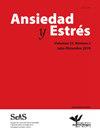Inteligencia Emocional y Ansiedad en tiempos de pandemia: Un estudio sobre sus relaciones en jóvenes adultos
IF 0.5
Q4 PSYCHOLOGY, CLINICAL
引用次数: 1
Abstract
Background and objectives: The COVID-19 pandemic has caused a large part of the world population to experience anxiety. The levels of Perceived Emotional Intelligence and emotional regulation can be key factors in modulating the levels of anxiety experienced and preventing the emotional disorders. The aim is to analyze how the IEP levels and forms of emotional regulation of reappraisal and suppression influence the anxiety experience. Materials and methods: 99 participants aged between 18 and 35 completed the Inventory of Anxiety Situations and Responses (ISRA-B) to analyze anxiety, the Trait Meta Mood Scale (TMMS-24) for IEP, the Emotion Regulation Questionnaire (ERQ) for emotional regulation and a sociodemographic questionnaire and situations related to the experience with COVID-19. Results: The measured IEP factors predict anxiety levels, high attention and low clarity and repair predict different anxiety responses and in different situations in variable percentages. Reappraisal and suppression factors do not predict anxiety levels. Women experience more anxiety than men and those who have had relatives or friends who have suffered from COVID-19 experience less anxiety. Conclusions: High levels of attention to feelings and low levels of clarity and emotional repair are risk factors for experiencing different types of anxiety in different situations, while the forms of emotional regulation of reappraisal and suppression do not seem to be relevant, sociodemographic factors such as being a woman or one’s own experiences in relation to COVID-19 seem to be risk or protective factors that should be studied to prevent anxiety in pandemic contexts.流行时期的情商和焦虑:对年轻人关系的研究
背景和目标:2019冠状病毒病大流行使世界上很大一部分人感到焦虑。感知情绪智力和情绪调节水平是调节焦虑水平和预防情绪障碍的关键因素。目的是分析重评价和抑制情绪调节的IEP水平和形式如何影响焦虑体验。材料与方法:99名年龄在18 - 35岁之间的参与者完成了焦虑情境与反应量表(israel - b)、IEP特质元情绪量表(TMMS-24)、情绪调节问卷(ERQ)和社会人口学问卷以及与新冠肺炎相关的情境分析。结果:IEP因子预测焦虑水平、高注意低清晰度和修复对不同情境下不同焦虑反应的预测百分比不同。重评和抑制因素不能预测焦虑水平。女性比男性更焦虑,而那些有亲戚或朋友患有COVID-19的人的焦虑程度更低。结论:高水平的情感关注和低水平的清晰度和情绪修复是在不同情境下经历不同类型焦虑的危险因素,而重新评估和抑制的情绪调节形式似乎不相关,社会人口因素(如女性或自身与COVID-19相关的经历)似乎是风险因素或保护因素,应该研究在大流行背景下预防焦虑。
本文章由计算机程序翻译,如有差异,请以英文原文为准。
求助全文
约1分钟内获得全文
求助全文

 求助内容:
求助内容: 应助结果提醒方式:
应助结果提醒方式:


